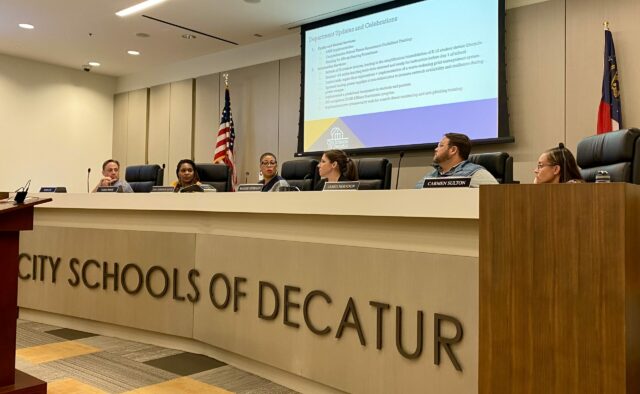Decatur Superintendent gives overview of dyslexia pilot program
 The City Schools of Decatur School Board met on Oct. 11, 2022, and discussed the dyslexia pilot program. Photo by Zoe Seiler.
The City Schools of Decatur School Board met on Oct. 11, 2022, and discussed the dyslexia pilot program. Photo by Zoe Seiler.
Decatur, GA — During the Decatur School Board meeting on Oct. 11, City Schools of Decatur Superintendent Maggie Fehrman gave an overview of the district’s dyslexia pilot program.
The dyslexia pilot program was created in 2019 when the governor signed Senate Bill 48, which requires schools to implement a statewide dyslexia screening mandate by 2024-2025, according to the Georgia Department of Education.
“We had our pre-pilot, which was our planning year, in 2019-20. Then we had years one, two, and three of the pilot from 2020 all the way to this year being our third year. Next year is kind of an implementation and prep year and then our fully launched year would be 2024-25,” Fehrman said.
According to Fehrman’s presentation, SB 48 requires the following to be put in place by 2024-2025:
– Development of policies for referring certain elementary students for dyslexia screening
– Create a dyslexia informational handbook to assist school districts
– Provide professional development opportunities on dyslexia for teachers
– Create a dyslexia endorsement for teachers
– Add instruction on dyslexia and response to intervention to existing standards for teacher preparation programs
– Screening of all kindergarten students for characteristics of dyslexia to begin in 2024-2025
– Conduct a three-year pilot program to demonstrate and evaluate the effectiveness of early reading assistance programs for students with risk factors for dyslexia
At the end of the 2018-2019 school year, CSD decided to apply to be a pilot district.
To view the full presentation, click here.
As a pilot district, CSD has to screen kindergarten through third grade students, which CSD decided to do district-wide. The district also has to provide appropriate reading interventions for students, comply with all state and federal laws, get parental permission to screen students, provide parents information, report findings and data to the state department of education, and attend all the meetings for a pilot district.
The 2019-2020 school was CSD’s planning year for the pilot program, and the 2020-2021 school year was the first year of the pilot program.
In year two, the district reviewed the universal screener data and shifted to using MAP reading in K-3, Acadiance in K-2 and i-Ready in third grade.
This school year, in year three of the program, the district is continuing Orton-Gillingham training, purchased Geodes Decodables for K-5 schools, and administered the universal screeners. Last month, the school system began reviewing MAP and Acadiance data.
Throughout October, CSD will go through the process of getting parental consent, evaluating students through the Kaufman Test of Educational Achievement (KTEA), forming the dyslexia task force, hosting various virtual events on dyslexia awareness.
In SB 48, the components of a universal screener should address difficulties in phonological and phonemic awareness, sound symbol recognition, alphabet knowledge, decoding skills, rapid naming, and encoding skills.
“The law says the universal screeners should test these six things. Not all of those six things are found in one single assessment,” Fehrman said. “You can’t just do one if you’re going to test all six, so we have two universal screeners, which is why we use MAP reading and the Acadiance screener.”
In year one, at Clairemont Elementary, of the 15 students who showed characteristics of dyslexia, all but three of them were already receiving some kind of additional support, Fehrman said
“The screener is doing its job. It’s helping us find those students who were not getting the support that they needed, which is great. But you can see we’re still missing some students, so how do we make sure we fix that is through continuing with universal screeners, providing interventions and tracking that data,” Fehrman said.
In year two, the screeners caught more students, but most of them overall were already receiving support, she added.
The next steps in the process are to look at the data and figure out if the interventions are working, Fehrman said.
“We’re going to continue with implementation of the pilot. We’re doing to collect and analyze that data longitudinally. We’ll have a good two and half years of data to look at. We’ve also initiated the task force, which will help us look at that data and make some decisions on what to do going forward,” Fehrman said.
The dyslexia task force will look at the expectations from the state, what was asked of CSD for the pilot, how well the district implement the pilot, and provide recommendations for improvements to the program.
“Also identifying what information do our parents need, what training and resources do our teachers need, as well as developing recommendations to share with the strategic planning and the board for what we could do long term and make sure that we’re continuously supporting students with dyslexia…,” Fehrman said.
If you appreciate our work, please become a paying supporter. For as little as $6 a month, you can help us keep you in the loop about your community. To become a supporter, click here.
Want Decaturish delivered to your inbox every day? Sign up for our free newsletter by clicking here.
